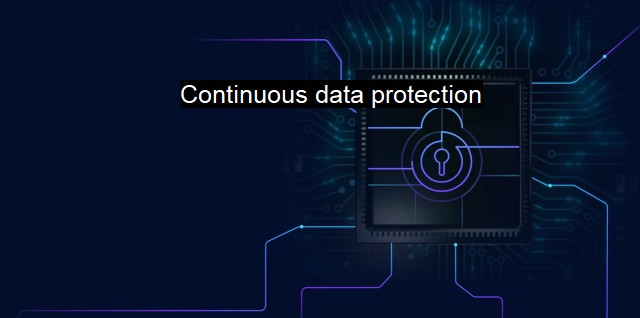What is Continuous data protection?
Continuous Data Protection: The Ultimate Defense Against Cyber Threats
Continuous Data Protection, often abbreviated as CDP, is an essential branch of cybersecurity used to protect and recover data in business networks and systems. CDP is based on automatic or scheduled backups and offers a comprehensive approach to protecting various types of data, including business documents, files, databases, application software, among others. This strategy allows IT and cybersecurity teams to restore data to any point in time, providing a failsafe against many forms of catastrophic data loss, including malware, ransomware, and other cyber threats.Continuous Data Protection has emerged as a crucial element within business information systems due to the increasing prevalence of cyber attacks that exploit and compromise data. Its importance is far-reaching in a world where cyber-attack sophistication levels are growing explosively.
To understand CDP in more depth, envision a piece of software that records your every keystroke. Now expand this analogy to an entire IT system, with the CDP solution working like a DVR for all data, continuously tracking changes. As the data changes over time, these changes are propagated across the entire system almost instantaneously. This makes the recovery process faster, more accurate and provides the ability to rollback hours, days, weeks, or even months to restore data.
The cyber world holds unpredictable and complex threats, including viruses, malware, ransomware attacks, and system crashes. Conventional restoration methods are often slow and cumbersome, sometimes requiring lengthy system downtime before the entirety of the lost data is retrieved. This delay could result in damaging consequences for businesses that rely heavily on their data to function. That is where a cybersecurity strategy like CDP comes into play; by offering reliable, timely restoration capabilities, it significantly reduces system downtime.
CDP's effectiveness in addressing the consequences of viruses or malware is remarkable. Traditional restoration methods often suffer great difficulty in pinpointing the exact moment when system infiltration occurred. This results in extensive restoration efforts, with some data potentially remaining compromised. In contrast, CDP offers precise point-in-time recovery options. This granularity enables the swift expulsion of the malicious infiltration and a comprehensive restoration of all affected data.
Closely tied with antiviral solutions, CDP functions as a final layer of protection. While an antivirus works to prevent, detect and remove harmful software, CDP complements this core function through its restoration capabilities. In the burgeoning cyber-landscape riddled with emergent advanced cyber-threats, these defection capabilities may occasionally fail, resulting in potential data compromise. Hence, antivirus and CDP are not replacements but complements, working together to ensure maximum system security and operability.
CDP is also particularly adept at minimizing the impact of ransomware. In ransomware attacks, hackers encrypt data, essentially locking it away, unless a ransom is paid. These attacks can cripple businesses by making crucial data unattainable. In this circumstance, the exceptionally swift recovery time provided by CDP becomes highly important. Because it constantly records data changes, CDP can return systems to a pre-attack state, effectively nullifying the ransomware's impact and avoiding the need to meet any ransom demands.
Continuous Data Protection is a significantly powerful tool in the cybersecurity landscape, especially with the growing emergence of data-intensive businesses, driving technology innovation and the economy at-large. It forms a crucial safety net and acts as an efficient crisis management tool when faced with increasing cyber threats. Together with antiviral solutions, businesses can maintain a reliable, secure and robust information infrastructure, fostering greater certainty in data and system security.

Continuous data protection FAQs
What is continuous data protection (CDP) in the context of cybersecurity and antivirus?
Continuous data protection (CDP) is a data backup and recovery technology used in cybersecurity and antivirus systems that captures all changes made to data in real-time or near-real-time, allowing for rapid restoration of information to a specific point in time.How does continuous data protection (CDP) differ from traditional backup methods?
Traditional backup methods typically involve regularly scheduled backups at specific intervals, such as daily or weekly. CDP captures changes to data as they occur, often in real-time or near-real-time, providing much quicker restoration of data in the event of a cybersecurity incident or virus attack.What are the benefits of using continuous data protection (CDP) in cybersecurity and antivirus systems?
CDP can provide faster recovery times than traditional backup methods, minimizing the impact of a cybersecurity incident or virus attack. Additionally, CDP allows for point-in-time recovery, meaning that specific versions of data can be restored to a particular point in time, which can be useful for compliance purposes or when dealing with data loss caused by human error.What are potential risks or downsides to using continuous data protection (CDP) in cybersecurity and antivirus systems?
One potential downside is that CDP can be more resource-intensive than traditional backup methods, due to the real-time or near-real-time capture of data changes. Additionally, CDP solutions can be more complex to implement and manage than traditional backup methods, requiring more expertise and training for IT professionals.| | A | | | B | | | C | | | D | | | E | | | F | | | G | | | H | | | I | | | J | | | K | | | L | | | M | |
| | N | | | O | | | P | | | Q | | | R | | | S | | | T | | | U | | | V | | | W | | | X | | | Y | | | Z | |
| | 1 | | | 2 | | | 3 | | | 4 | | | 7 | | | 8 | | |||||||